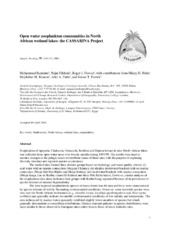| dc.description.abstract | Zooplankton (Copepoda, Cladocera, Ostracoda, Rotifera and Diptera larvae) in nine North African lakes was collected from open water areas over twenty months during 1997/99. The results were used to monitor changes in the pelagic micro-invertebrate fauna of these sites with the purpose of exploring diversity structure and regional species occurrences. The studied sites formed three distinct groups based on hydrology and water quality criteria: (i) acid water with no marine connection (Megene Chitane); (ii) alkaline freshwater/brackish with no marine connection (Merja Sidi Bou Rhaba and Merja Bokka); (iii) freshwater/brackish with marine connection (Merja Zerga, Lac de Korba, Garaet El Ichkeul and three Nile Delta lakes). However, cluster analysis of the zooplankton data alone indicated four groups with Korba being separated because of its prevalence of species tolerant of summer hypersalinity. The total regional zooplanktonic species richness found was 88 taxa and these were characterized by species tolerant of widely fluctuating environmental conditions. However, some recorded species were very rare for North African freshwaters (e.g. Alonella excisa, Leydigia quadrangularis and, Ilyocryptus sordidus) and generally indicate favourable environmental conditions of low salinity and temperature. The sites influenced by marine waters generally exhibited slightly lower numbers of species but which generally demonstrate cosmopolitan distributions. Distinct seasonal patterns in species distributions were more similar to those observed in European lakes rather than to those of lower latitudes sites. Zooplankton play a key role in maintaining aquatic ecosystem quality in the North African study lakes and the community distributions described for the late 20th century help set biodiversity base-line data for future studies. If the remaining wetland lakes in this region are to persist as important resources during the 21st century, they will need to be managed in a way that ensures that aquatic diversity is maintained. | en_US |
